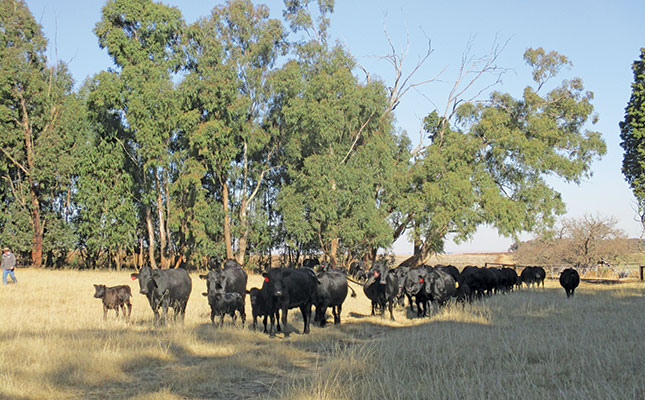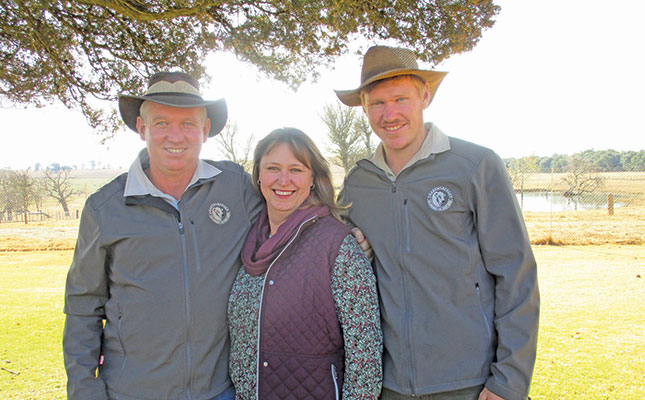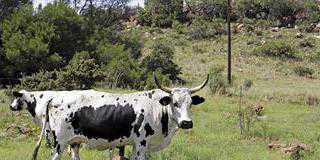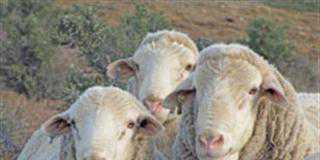
Photo: Suppleid
The Drakensberger cattle breed is as much a part of South Africa as the great mountain range that shares its name. When the Dutch-speaking settlers decided to migrate northwards in 1836 to escape the Cape’s British colonial administration, it was mostly Drakensbergers that were used to pull their wagons.
In those days, the breed was used primarily as draft animals, and due to this, the breeding focus was on their front quarters in order to increase pulling strength. Gradually, however, the focus shifted to the hindquarters in order to increase beef production. So says Petrus Taljaard, owner of Talman Drakensbergers, near the Mpumalanga town of Ermelo.

“To be honest, the Drakensberger doesn’t have a single exceptional feature. Rather, it’s an exceptional all-rounder,” he says. “You can milk it, put it in a feedlot, let it graze on natural veld or put it in an ultra-high-density grazing camp. It’ll be very competitive against all other breeds in all of these situations.”
Mixed farming
Taljaard’s son, Pikkie, joined the family farming business this year after completing his degree in mechanical engineering at the University of North-West’s Potchefstroom campus last year. Currently, he’s responsible for the farm’s sheep, and will take over more and more of the crop production as time goes by.
He started the operation in a remarkably wet year. As a rule, the Vaal River nearby overflows its banks about twice per year, whereas in 2022 it has done so six times already!
The mixed farming operation is spread over several pieces of land, but all of them are situated at around 1 680m above sea level, says Taljaard.
They also have cattle grazing in the Amersfoort area, mostly on red grass (Themeda triandra). On their main property, the cattle graze mostly on red grass, kikuyu (Cenchrus clandestinus) and a number of lovegrasses (various Eragrostis types).
“We also have several old lands that were planted by previous generations. Years ago, people ploughed anywhere and when their yields decreased, they simply planted next to that land again,” says Taljaard. “Those were wonderful days for cattle, because they fattened up on maize and other [grain].”
As a bonus, the cattle also contributed to the farm through the liberal dumping of manure.
“My father had a land that lay fallow for 30 years. Nothing would grow on it until manure was worked in. I often say that all you need for growth is black cattle’s manure. Anything will grow in that
“It’s truly all just grace. We’re merely stewards of the land and we really need to be thankful for what we’ve received.”
Nature knows best
The shiny black coats of the Drakensberger is probably the breed’s most outstanding visual trait.
“It’s important to note that the Drakensberger has a shiny black coat,” says Taljaard.
“There’s a big difference between a [matt] black coat, which attracts heat, and a shiny black coat, which deflects it.”
In the past, the breed was criticised for its black coat, but this was often due to farmers confusing it with the matt-black coat of crossbred Friesian cattle. The Drakensberger is an indigenous animal and is adapted to withstand the African sun, according to Taljaard.
“You often see that wild animals might have lighter fur, but their skin is dark. That’s because a darker skin helps to protect it from the sun.”
In addition to its hardiness, the Drakensberger demonstrates tick resistance, thanks to its skin. However, Taljaard cautions that there can be more variation within a breed than between different breeds.
“We might dip our animals twice a year to diminish tick numbers, but it’s not set in stone,” he says.
“Some farmers don’t dip their herds at all, but that’s not part of our management strategy. We believe in farming with ticks and rather controlling the numbers.
“We don’t have redwater, but when we buy in animals, we do struggle with that. I believe this has to do with herd management. A farmer who farms with nature doesn’t struggle with nature. But when you start deviating from nature, that’s when you start having problems.
“It’s not bad to have ticks on your cattle, but there should not be so many that their blood is sucked out in large volumes. That’s when the animals start losing condition and become ill.”
Until about five years ago, the Taljaards used slow-release ivermectin on the farm.
“We used to inject the animals in December and then again in March,” says Taljaard.
However, this apparently logical parasitic remedy became less so as time went by, and eventually they stopped using it on the farm.
“I came to realise that ivermectin was killing bacteria in animals’ intestines, which meant it was destroying the bacteria in animal’s dung, and this in turn destroyed the healthy bug life (especially dung beetles) that should form part of the farm’s biodiversity.
“Dung beetles help control flies, because they process manure that would have attracted flies if they weren’t there,” he says.
In the years since he has stopped using ivermectin, Taljaard has noticed that the tick population on his farm has neither increased nor decreased. He therefore now only spray-dips the cattle with amitraz, when needed. Amitraz paralyses the ticks’ jaws, and their grip subsequently loosens and they fall off the cattle.
Cattle needed to be rotated, says Taljaard. “They usually first graze where the sweet grass is, and then they move to the next tastiest grass, and then the next. The more an animal moves through a camp, the greater the likelihood that several ticks will decide this animal is the perfect host to jump onto.”
Converting feed into calves
Although Taljaard is not a committed advocate for ultra-high-density grazing, he can see the logic in such a system.
“If a farmer could manage such a system perfectly, it would be ideal. However, you need to know that you’ll probably ultimately pay with a reduced conception rate as well as weaning weight. In theory, the more cattle you can raise on your land, the higher your profitability per hectare. However, it requires detailed mathematics for you to calculate these figures.”
Currently, the Talman Stud’s intercalving period stands at 417 days. This means
that Taljaard is in general able to wean his seven-month-old calves at a weight of 200kg and he then has an 80% reconception rate.
“Ideally, you’d like to wean a seven-month-old calf at a weight of 250kg, because that will push your reconception rate up to 90% and you’ll also have a heavy weaner. However, if you wean his seven-month-old calves at only 150kg, you’ll have a reconception rate of less than 60%.
“A dam first looks after herself. Then she looks after the calf by her side, and only then will she become pregnant again.”
A demanding environment
On their farm, which is subject to very harsh winter conditions, the Taljaards are generally able to wean at around 200kg, depending on the time of year. However, if he is able to wean a calf during the prime period, Taljaard can push the weaning weight to 220kg, or even 250kg in rare instances. But if a cow calves late, he will look at a weaning weight of 150kg.
“For me, a calf will be weaned late if it’s born between October and November. From March onwards, the grass on my farm starts losing its nutritional value.”
Taljaard’s aim is for his cows to calve between July and August, because he can then wean the animal on grass that’s in its prime.
“Our grass has great carrying capacity for only five of the 12 months of the year. As it takes seven months to rear an animal, we need to give additional feed (hay) for two more months.
“I prefer my cows to calve earlier and then to feed my cattle for the first two months, as this helps the calf gain weight and also helps the dam from losing too much condition [before] reconception.”
Taljaard is ready to admit problems that he is currently experiencing in his herd.
“I’ve made mistakes and I need to own up to them. It’s not fair to punish a cow for a farmer’s mistake. I believe the Drakensberger has some of the best maternal traits of all breeds. One of these is the ability to produce enough milk. And let’s face it, in the end, it’s the dam that makes the weaner.”
Email Petrus Taljaard at [email protected].










